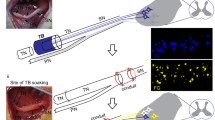Summary
Non-specific re-innervation of target organs caused by misdirected axonal growth at the repair site is regarded as one reason for a poor functional outcome after peripheral nerve transsection and repair. This study investigates the rate of aberrant re-innervation and its influence on motor recovery in the rat sciatic nerve using artificial sheets as barrier between tibial and peroneal nerves.
The sciatic nerve was transsected and repaired as follows: epineural sutures (A×6), fascicular repair of tibial and peroneal nerves respectively (B×8), and the same as in group B, but separating both nerves using an Integra®-sheet with silicone (C×8), or Integra® without silicone (D×8). As control, solely the tibial nerve was transsected and repaired (E×5).
Final investigations after 4 months revealed that in group C, 50% of the Integra®-silicone sheets were dislocated. No dislocation was found in group D. Muscle contraction force of the gastrocnemius muscle was significantly higher in group E as compared to all other groups. However although not significant, group D showed a consistently higher muscle contraction force than groups A, B, and C. Histology in groups A, B, and C with dislocated sheets demonstrated multiple axons growing from the tibial to the peroneal nerve and vice versa. In groups D and E, no such axonal growth was visible. These findings were confirmed by a significantly higher rate of specific re-innervation of the soleus muscle using sequential retrograde double labelling technique.
Results of this study suggest that an artificial sheet such as Integra® bears the potential of preventing aberrant re-innervation between repaired adjacent nerves resulting in improved motor recovery. Clinically, this technique may be of importance for brachial plexus, sciatic nerve, and facial nerve repair.
Similar content being viewed by others
Author information
Authors and Affiliations
Rights and permissions
About this article
Cite this article
Lutz, B., Ma, SF., Chuang, D. et al. Specificity of Reinnervation and Motor Recovery after Interposition of an Artificial Barrier Between Transected and Repaired Nerves in Adjacency – An Experimental Study in the Rat. Acta Neurochir (Wien) 143, 393–399 (2001). https://doi.org/10.1007/s007010170095
Issue Date:
DOI: https://doi.org/10.1007/s007010170095




